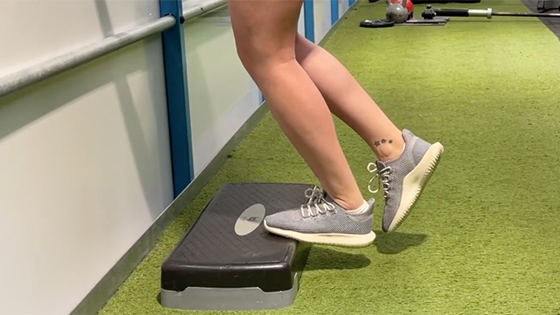SHIN SPLINTS REHABILITATION
A Step-by-Step Rehab Program by Elite Level Sports Physiotherapist Paul Tanner.

What are Shin Splints?
Shin splints, also known as medial tibial stress syndrome (MTSS), are a common cause of pain along the lower leg, usually felt on the inside of the shin. Symptoms tend to build gradually, easing with rest but returning once training resumes. If you’re caught in this cycle of recurring pain, our rehabilitation app provides a clear, step-by-step plan. It guides you from injury through recovery and back to full competition fitness.
Cure My Shin Splints
Our step-by-step shin splints rehabilitation app is designed to help you heal, recover, and get back stronger.
Why Structured Rehabilitation Is Essential
Shin splints cause pain along the inside of the tibia and often worsen if training continues without proper management. Our structured program combines load modification, mobility, and progressive strengthening to calm symptoms, address underlying risk factors, and allow you to return to running and sport safely.

Is it suitable for me?
This program is suitable for anyone with shin splints, whether your pain is recent or has been recurring for months. It is based on the same evidence-based methods trusted by elite athletes but adapted for everyday runners, footballers, and fitness enthusiasts. In addition, the program adapts to your progress, ensuring you only move forward when your symptoms, strength, and control allow you to.
To access the full program, view our subscription plans.
“Trusted by physiotherapists who have worked with Premier League players and England Rugby.”
Program Author
Paul Tanner
Paul is Head of Medical at Bristol City FC and has previously held senior roles at Millwall Football Club, providing comprehensive match-day and training-ground physiotherapy and medical support.
His career also includes positions as First Team Physiotherapist at Norwich City FC and Senior Physiotherapist with London Wasps Rugby, giving him extensive experience at the highest levels of professional sport.

How does it work?
The program consists of 4 phases. You progress through the phases, only moving on to the next phase when you have reached specific exit criteria.
Elite-level sports physiotherapist Paul Tanner introduces each phase through guided videos. The app provides daily instructions (“Today’s Tasks”) and tracks your progress, which can be reviewed later by you, your coach, or your physio. This program doesn’t just aim to heal your injury—it’s built to help you return stronger, more resilient, and ready for long-term performance.
Phase 1
Phase 1 begins as soon as possible after injury and is known as the acute phase. It can last from 48 hours to 2 weeks or more, depending on how bad your injury is. The aim of phase 1 is to reduce pain and inflammation, as well as protect the tissue from re-injury and delay recovery.
Phase 2
The aim of phase two is to ensure your lower leg stays pain-free, as well as identify possible causes. Exercises are aimed at improving mobility and condition of the lower leg muscles.
Phase 3
The aim of phase 3 of our Shin splints rehabilitation program is to continue to protect the injured leg while you begin to return to running. This means adding load to the calf and speeding up movement patterns.
Phase 4
Although by now you will be feeling pretty good, it is important to complete this phase. This is the end stage where we return you to normal training and focus even more on sports-specific type exercises.
What’s included?
The program includes the following:
Treatment & healing
This covers how and when to apply treatment such as cold therapy & compression, heat, massage, taping & bracing.
Stretching & mobility
These aim to maintain a normal range of movement in the ankle, knee, and hips. They begin early in stage one with simple active ankle movements and gradually progress to more dynamic hip mobility drills.
Strengthening exercises
These exercises maintain and improving specific muscle strength around your knee joint. They begin with simple isometric exercises and become increasingly more demanding, with heavier loads and unpredictable movements.
Movement control exercises
These are proprioception-type exercises, aimed at improving your balance, control, and spatial awareness. Again, they start with simple balance exercises and progress to advanced balance board movements.
Functional exercises
Functional exercises bridge the gap between basic rehabilitation and sports-specific type drills. They begin with walking drills and progress through skipping-type sprint drills and agility training.
Got Questions? We’ve got answers.
How long do shin splints take to heal?
Most cases improve within 2–6 weeks if managed early. More stubborn shin splints can take 2–3 months or longer, especially if training loads remain high. A structured rehabilitation plan speeds recovery and helps prevent setbacks.
What is the best treatment for shin splints?
Treatment focuses on reducing stress on the shin, improving calf and foot strength, and gradually returning to activity. Our SportsRehab app gives you a step-by-step rehabilitation program with daily tasks, exercise videos, and expert physiotherapist guidance to support safe recovery.
What causes shin splints?
Shin splints are usually caused by repeated stress on the tibia (shinbone) and surrounding tissues. Risk factors include sudden increases in running mileage, hard surfaces, poor footwear, and weak lower-leg muscles.
Can shin splints turn into a stress fracture?
Yes. If pain is ignored and training continues, shin splints can develop into a tibial stress fracture. This is why early treatment and progressive rehabilitation are essential.
Visit our full FAQ page for detailed answers about the programs and using sportsrehab.app

